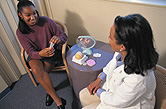
FRIDAY, Jan. 20 (HealthDay News) — Americans with access to three key features of high-quality primary care have a lower risk of death, according to a new study.
These features are comprehensiveness, patient-centeredness, and evening and weekend office hours, the University of California, Davis researchers said.
Comprehensiveness includes providing care for new health problems, preventive care and referrals to other health care professionals. Patient-centeredness means that health care providers listen to and seek a patient’s advice when deciding on treatments.
The researchers analyzed data from more than 52,000 people aged 18 to 90 who took part in the 2000-2005 U.S. Medical Expenditure Panel Surveys, which asked participants about their health and health care.
After adjusting for patient age, health status and a number of other factors, the researchers found that access to the three important features of quality primary care was associated with a much lower risk of death (hazard ratio 0.79) during up to six years of follow-up. A hazard ratio below 1.0 implies a lesser risk.
“Our findings suggest that ongoing efforts to provide all Americans with a ‘medical home’ offering the primary-care attributes we studied could yield major public health benefits,” lead author Anthony Jerant, a professor of family and community medicine, said in a university news release.
“Medical home” refers to a national movement that seeks to ensure people have access to patient-centered, comprehensive and continuously available primary-care services, he explained.
Jerant and colleagues also found that people who belong to racial/ethnic minorities, who are poor and less educated, and who don’t have health insurance are much less likely to have access to the three important features of high-quality primary care.
“Although the wider adoption of primary care attributes may have promise for mitigating health disparities, interventions to promote equitable access to such attributes may be required to fulfill this promise,” the researchers wrote in the study published in the January/February issue of the journal Annals of Family Medicine.
More information
The U.S. National Library of Medicine offers tips for choosing a primary care provider.

